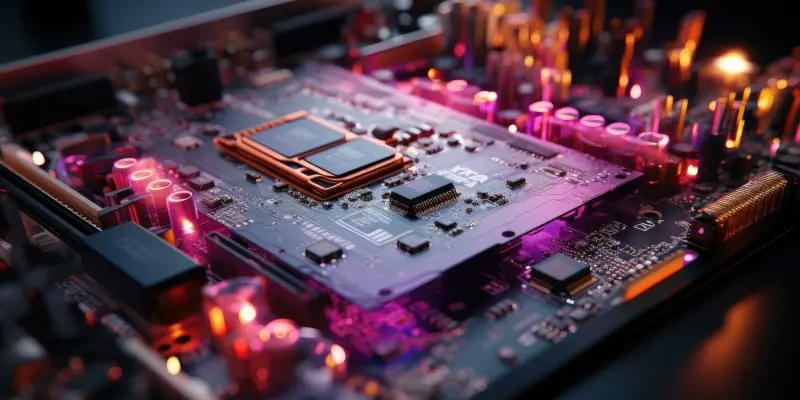In the fast-evolving world of semiconductor technology, Intel has embarked on a bold quest to reclaim its leadership position through significant technological advancements and strategic shifts. Under the guidance of CEO Lip-Bu Tan, Intel has unveiled ambitious plans to overhaul its semiconductor manufacturing prowess with the introduction of new process nodes and advanced packaging technologies. These moves come amidst stiff competition from industry rivals, particularly TSMC, which has been setting the pace in recent years. By targeting innovations that promise improved performance and integration, Intel aims to redefine its stature in the technology arena. The emphasis is not only on catching up with competitors but on leapfrogging them through pioneering technologies and improved production timelines. The ongoing transformation reflects Intel’s resolve to adapt swiftly to industry demands, ensuring its position at the cutting edge of semiconductor advancement.
Technological Innovations at the Forefront
A major linchpin in Intel’s plan is the development of the 14A and 18A processes, with the 14A process currently in its early testing phase. By incorporating PowerVia 2.0 technology, Intel intends to enhance power delivery efficiency, setting a stage for power-efficient transistors using backside power supply. This technological leap positions Intel ahead of TSMC by potentially two generations in terms of backside power delivery. Concurrently, Intel’s enhancements to the 18A process hold the potential to solidify its leadership status. The company is introducing performance-centric variants of this process, namely 18A-P and 18A-PT nodes. These are engineered to surpass previous iterations by leveraging innovations like Foveros Direct 3D hybrid bonding. This advancement enables stacking of multiple chiplets using Through-Silicon Vias (TSVs), highlighting Intel’s prowess in chiplet interconnect technologies, rivaling advancements like AMD’s Ryzen X3D CPUs. Commencing risk production of the 18A process, Intel envisions full-scale rollouts swiftly, with a timeline reflecting direct competition with TSMC’s N2 node as both aim to dominate the high-performance market segment.
Intel’s strategic outlook extends beyond mere innovations in process technology, with a comprehensive focus on packaging advancements. The introduction of EMIB 2.5D, Foveros-S 2.5D, and other packaging technologies underscores Intel’s commitment to versatile and cost-effective connections of multiple complex dies. EMIB (Embedded Multi-die Interconnect Bridge) technology, a mainstay since 2017, continues to evolve, offering enhanced integration capabilities through TSVs. Innovations such as Foveros Direct 3D further exemplify Intel’s ambition to optimize power-per-bit performance and bandwidth, aligning with the demanding requirements of client and data center applications. As Intel advances toward these goals, the existence of EMIB 3.5D technology illustrates its prowess in constructing cohesive yet complex systems, exemplified by the Data Center GPU Max Series SoC, a marvel of over 100 billion transistors. This blend of groundbreaking process and packaging advancements typifies Intel’s effort to not only reclaim but also redefine industry leadership by delivering comprehensive solutions well-suited to modern technological demands.
Strategic Alignment and Industry Collaborations
While technological dreams are a pivotal part of Intel’s strategy, the firm recognizes the need for robust ecosystems and partnerships to realize these ambitions. Focus on forming an inclusive foundry ecosystem is part of Intel’s newly defined strategy under Tan’s leadership. This involves deprioritizing certain processes, like the 20A, to focus resources on strengthening partnerships with industry powerhouses such as Synopsys and Cadence. These collaborations are central to Intel’s vision of aligning quickly with partner expectations and enhancing foundry performance. By fostering strategic alliances, Intel seeks to overcome previous challenges, ensuring timely product delivery and addressing the intricate demands of semiconductor manufacturing. Such partnerships are crucial in navigating the complexities of global supply chains and enhancing Intel’s capacity to deliver innovative, market-ready technologies efficiently.
Underpinning these collaborative efforts is Intel’s commitment to customer-centric approaches and fulfilling evolving industry demands. This strategic orientation reflects an understanding of the competitive landscape where quick adaptation is necessary to remain viable. By channeling efforts into constructive partnerships and prioritizing customer satisfaction, Intel aspires to enhance its market standing and regain its stature as an industry titan. As Intel progresses with initiatives that reflect a well-coordinated strategy balancing technological prowess with strategic partnerships, the repositioning efforts mark a critical step in shaping the future trajectory of the company in the semiconductor domain.
Forward Momentum and Future Prospects
Intel’s ambitious plan includes developing the 14A and 18A processes, with 14A in early testing. By using PowerVia 2.0, Intel aims to boost power delivery, pioneering efficient transistors with backside power supply, potentially advancing two generations ahead of TSMC. Simultaneously, Intel’s 18A process advancements could secure its market leadership. This process introduces high-performance variants like 18A-P and 18A-PT nodes, surpassing past versions through innovations like Foveros Direct 3D hybrid bonding. This progression allows for stacking multiple chiplets using Through-Silicon Vias (TSVs), demonstrating Intel’s expertise in chiplet interconnect technologies against competitors like AMD’s Ryzen X3D CPUs. Intel plans to begin risk production and anticipates swift full-scale rollouts, contesting with TSMC’s N2 node in the high-performance market. Furthermore, Intel’s strategic vision emphasizes packaging innovation through EMIB 2.5D and Foveros-S 2.5D technologies, ensuring versatile connectivity and optimizing power-per-bit performance.

